New Declassified Documents on RFK Assassination Reveal Shocking Details
A lone gunman, a perfect autopsy, and a trail of buried secrets. The new CIA files don’t just raise questions—they blow holes in the official story.
What if everything we thought we knew about Robert F. Kennedy’s assassination wasn’t the full story?
We’ve all heard the official version: RFK wins the California primary, gives a speech, walks through a kitchen pantry, and then—bang. Sirhan Sirhan steps out of the shadows, pulls the trigger, and a bright, promising life is cut short.
Case closed, right?
Not exactly.
Newly declassified CIA documents are cracking that case wide open—and what’s inside is... unsettling. These files, long buried in vaults and bureaucracy, hint at missing evidence, strange surveillance, and the possibility that Sirhan didn’t act alone. Some pages even suggest the CIA had eyes on RFK long before that night.
Let that sink in.
Why would the CIA track a presidential candidate from their own country?
And why are we only seeing these documents now, more than five decades later?
These aren’t just random conspiracy theories floating around Reddit. These are official records—sanitized, yes, but revealing just enough to make you wonder what else is still hidden.
In this article, we’re going to break down what’s in those documents and why they matter:
What the files actually reveal (and what they don’t)
The biggest inconsistencies in the case
Why some experts believe RFK’s murder was bigger than one man with a gun
And how all of this fits into the long, twisted legacy of the Kennedy family
This isn't just a history lesson. It’s a cold case that’s suddenly warming up.
So if you've ever questioned the "official story" or wondered what really happened in that hotel pantry in 1968, you're in the right place.
The Assassination of Robert F. Kennedy
It was supposed to be a night of celebration.
June 5, 1968. Just after midnight. The ballroom of the Ambassador Hotel in Los Angeles pulsed with cheers, flashbulbs, and that rare, electric feeling that change might actually be possible. Robert F. Kennedy had just won the California Democratic primary. He was riding a wave of momentum—one that looked destined to carry him all the way to the White House.
Then it all went sideways.
A Dark Day in American History
RFK finished his victory speech and turned to exit through a service route behind the stage—a shortcut through the hotel kitchen, meant to avoid the crowd. A few campaign staffers, journalists, and hotel workers followed.
That’s when a young man stepped forward, raised a small revolver, and pulled the trigger.
Sirhan Sirhan, a 24-year-old Palestinian immigrant, fired eight shots in quick succession. Kennedy fell. Five others went down with non-fatal wounds. Amid the panic, Sirhan was wrestled to the ground and disarmed.
Blood spread across the tile floor. RFK’s eyes fluttered. A teenage busboy, Juan Romero, knelt beside him, cradling his head. Cameras snapped. The moment was frozen forever.
Kennedy died the next day, never regaining consciousness.
The Immediate Aftermath
The country was stunned.
Another Kennedy—gone. Just five years after JFK’s assassination, history seemed to echo itself in the cruelest possible way.
The news broke like a wave across America:
Civil rights leaders mourned a powerful ally.
Vietnam protesters lost their strongest voice in Washington.
Working-class families saw their champion taken mid-stride.
TV anchors choked on their own words. Newspapers ran the same photo: RFK on the floor, eyes half-closed, a rosary dangling from Romero’s hand.
It didn’t feel real.
RFK’s Place in the Kennedy Legacy
To understand the weight of this loss, you have to understand what RFK meant.
He wasn’t just John F. Kennedy’s little brother. By 1968, he had carved out his own identity: fierce, compassionate, brutally honest. He stood with Cesar Chavez and marched with Black activists in the Deep South. He called for peace while others demanded war. He talked about poverty—not just numbers, but people.
He was flawed.
Human.
But his vision cut through the noise.
His assassination wasn’t just the end of a campaign—it felt like the end of something larger. Like hope itself had been dragged behind the curtain and silenced.
THE OFFICIAL STORY
The official story goes like this:
Sirhan Bishara Sirhan, a 24-year-old Palestinian immigrant, walked into the kitchen pantry of the Ambassador Hotel just after midnight on June 5, 1968. He was angry—furious, really—about Robert F. Kennedy’s vocal support for Israel, especially after the Six-Day War. He waited for RFK to pass through, pulled out a .22 caliber revolver, and opened fire.
He was tackled within seconds. Caught red-handed. No question.
Kennedy was hit three times, including once behind the ear—fatal. Five others were wounded. Sirhan confessed almost immediately, and his journal later revealed an eerie, repeated phrase:
“RFK must be assassinated... RFK must be assassinated... RFK must be assassinated...”
It was open-and-shut. Sirhan was convicted of first-degree murder and sentenced to death in 1969—though that sentence was later commuted to life in prison when California briefly abolished the death penalty. He’s been denied parole more than 15 times, despite claiming he has no memory of the shooting.
Sounds airtight, right?
Not quite.
Where the Official Story Starts to Crack
At first glance, it looks simple: one gunman, political motive, swift justice.
But the deeper you look, the messier it gets. And conspiracy theorists? They haven’t been spinning wild stories—they’ve been pointing out real, documented inconsistencies in that official version.
Here are the biggest ones:
1. The Fatal Shot Came from Behind
According to autopsy reports, the shot that killed RFK was fired from behind his right ear, at point-blank range—less than an inch away. But multiple witnesses said Sirhan was in front of Kennedy the entire time.
Not behind.
Not even close.
So how does a man standing in front shoot someone from behind?
2. Sirhan’s Gun Only Held 8 Rounds
Eight shots. That’s all Sirhan’s revolver could fire without reloading. But some eyewitnesses—and even audio analyses conducted later—suggest there were more than eight shots fired.
Some say up to thirteen.
The math doesn’t work.
3. Sirhan Doesn’t Remember It
Sirhan has claimed for decades that he has no memory of the shooting. He says he felt like he was in a trance—hypnotized, even. While that might sound like a convenient excuse, court transcripts and psychiatric evaluations from the time show he was oddly detached and easily manipulated.
It gets weirder when you realize this all happened during the height of MKUltra, the CIA’s infamous mind control program.
Coincidence?
4. Missing or Mishandled Evidence
From lost security footage to bullet holes that were never properly accounted for, there are gaps in the evidence that should’ve closed this case. The LAPD destroyed key pieces of the investigation years later—photographs, audio recordings, ballistic samples—all tossed out before anyone could reexamine them.
Even today, newly declassified documents reveal that the CIA had been monitoring RFK’s campaign.
Why would they do that?
He wasn’t a threat—unless someone thought he was.
The New Declassified Documents
If you're the type who wants to dig through the raw files yourself, here's the full trove released June 12, 2025:
👉 Declassified RFK Assassination Documents – CIA Reading Room
Now for the TL;DR crowd:
No, the CIA didn’t flat-out admit to killing Robert F. Kennedy.
But what these documents do contain is… a little weird.
A little off.
And more than a little worth paying attention to.
Think of it like this: the files don’t close the case—they pry it open just a little wider.
Here are some of the most intriguing and eyebrow-raising pieces from the new batch.
Handwritten Notes: “Sirhan Questions”
One document reads like someone thinking out loud in the margins of history:
"1) Is this man mentally ill?
2) If so, is the illness so that [unclear] would not be aware of what he was doing, that he was commiting a crime.
3) If so, could he be the tool of a conspiracy - Would a conspiratorial group utilize a person in his mental condition.
4) can the statement in the notes that RFK must die be interpreted literally that he systematically planned the assasination well in advance.”
Whoever wrote this wasn’t just questioning Sirhan’s sanity—they were asking whether his mental state made him a perfect pawn.
Personality Profile: Not Your Typical Assassin
Another file lays out a psychological profile of Sirhan Sirhan. The analysts note:
“Under no circumstances would we have predicted he was capable.”
“Odds against success were tremendous.”
“He could be a tool of a conspiracy... but unlikely to follow precise instructions.”
They compare him to the impulsive killers of Garfield and McKinley, not the cold “planners” like Booth or Oswald.
The subtext?
Sirhan may have fired the gun—but he may not have understood the script.
CIA Program “QRSENSE” – RFK as a Witting (and Unwitting) Informant?
Yes, you read that right.
According to Document RFK 201, Kennedy was involved—knowingly and unknowingly—in a CIA project called QRSENSE, tied to a 1955 USSR trip and a 1964 political training institute.
Key line?
“Agency interest not to be shown during investigation.”
Even RFK himself apparently got suspicious of the CIA’s constant presence. One memo says he “questioned why he was being passed from one person to another.”
So… was the future presidential candidate under surveillance by his own government? Sure looks that way.
Sirhan's Background: Drugs, Fights, and Zero Terrorist Ties
Other reports dive into Sirhan’s history:
Used hashish and drank heavily with his brother Sadallah.
Allegedly got into a fight with a Cuban exile weeks before the shooting and said, “What we need in the U.S. is another Fidel Castro.”
The person he got in a fight with said Sirhan accused the man of being a CIA agent.
But despite all that, both the CIA and Jordanian officials found no links between Sirhan’s family and any known terrorist organizations.
So if he wasn’t tied to a movement… what was he tied to?
The “Al-Fatah” Theory – Or Just Convenient Finger-Pointing?
A memo dated June 14, 1968 quotes Joseph Boles, a political advisor to the executive suite at Occidental Petroleum, claiming—with absolute confidence—that RFK’s assassination was the work of Al-Fatah, a Palestinian resistance group.
His reasoning? The moment he heard the name Sirhan, he just knew.
That’s it. No evidence. No investigation. Just gut instinct... from a guy whose company had massive oil interests in the Middle East.
In the 1960s, the CIA had its fingerprints all over the globe—installing friendly regimes, crushing leftist movements, and protecting U.S. corporate interests (especially oil). This was post-Mossadegh Iran, post-Bay of Pigs, pre-Pinochet Chile. The Cold War was a game of chess, and petroleum companies? They were practically playing side-by-side with Langley.
So when a corporate insider tied to Big Oil confidently blames a high-profile political murder on a Middle Eastern resistance group—without evidence—it’s hard not to raise an eyebrow.
Was it a genuine suspicion? Or a narrative just waiting for the right name to plug in?
A Chilling Premonition? Beirut Rumor Weeks Before Shooting
One report describes a rumor floating around Beirut on May 18, 1968—nearly three weeks before RFK’s death—that he had already been shot.
It was passed up the chain from a USAID subcontractor, through a Raytheon manager, to the CIA.
Wild coincidence? Maybe. But if someone did know in advance, the implications are spine-chilling.
A Confession on the Water? “We’ve Already Taken Care of RFK”
Another strange tale: A Spanish national named Agustin Correa Rafael claimed he overheard a man on a boat—“Fatima”—saying:
“We’ve already taken care of Robert Kennedy. His brother will fall soon.”
(referring to Ted Kennedy)
The man? A U.S. citizen from Dallas involved in smuggling. A known associate of a Portuguese count who owns a castle. (Yes, really.)
It sounds like the start of a bad spy novel. But it’s in the documents, and the conversation took place on June 12, 1968—just days after RFK’s death.
The CIA and LAPD Agreement: No Public Attribution
One memo confirms that after the shooting, the CIA shared info with the LAPD on Sirhan—but on one strict condition:
None of it could be made public or attributed to the Agency.
That kind of cloak-and-dagger deal doesn’t scream “nothing to hide,” does it?
Also notable:
“The Agency was able to inform the LAPD that there was no indication that Sirhan had ever been connected with any terrorist organization.”
So once again—Sirhan wasn’t known to anyone. Not to terror groups. Not to the CIA. Not to anybody.
Until… suddenly he was.
The Massive “Sirhan Sirhan 201” File
At 814 pages, this document is a monster. But here are some of the standout facts:
Sirhan immigrated to the U.S. in 1957 at age 13. Never left the country again.
His family came from poverty—Greek Orthodox Christians in a Muslim-majority region.
His father, Bishara, built a home in Taybeh in 1960, funded largely by money from the U.S.. He then moved back to Taybeh about a year later and remained there the rest of his life. His family stayed behind in America.
His brother, Sharif Sirhan, had multiple drug-related arrests and once drove a car off a cliff. He was also arrested for possession of marijuana and LSD.
Not exactly the profile of a trained international hit squad.
So What Does It All Mean?
None of these documents scream “conspiracy!” in flashing red letters.
But they sure whisper it.
They show confusion, conflicting reports, and a possible pattern of intelligence activity around RFK.
They raise questions about mind control, foreign interests, and CIA surveillance.
And they expose cracks in the story we've been told for decades.
So no—the CIA didn’t admit to killing Robert F. Kennedy. But they left behind a trail of smoke thick enough to wonder where the fire really started.
MUNIR’S STORY: The Brother Behind the Headlines
It’s easy to forget that assassins—especially the ones history remembers—have families, childhoods, pets, and complicated lives that don’t fit neatly into a two-paragraph FBI summary.
So let’s talk about Munir Sirhan—Sirhan Sirhan’s younger brother—and the story he told the Seattle Times.
Because behind the headlines, the trial transcripts, and the grainy kitchen photos, there’s this: two brothers growing up in Pasadena, trying to become American.
“If Anybody Tried to Hurt Me, He’d Step In”
Munir remembers Sirhan as protective. Not angry. Not dangerous. Not political.
“If anybody was trying to do me any harm, he confronted people,” he told the Seattle Times. “Listen, this is my little brother. I don’t want anybody hurting him.”
That’s the man he knew. Not the assassin. The older brother who looked out for him.
Dogs, Church, and ROTC
The Sirhans weren’t plotting revolutions. They were walking the dog, going to church, raising hamsters. Their pets had names like Tasha, Blue, Herbie, and even Father John, the family cat.
They went to Westminster Presbyterian Church every Sunday. Their mother worked in the nursery school. Sirhan joined the ROTC at John Muir High—the same school Jackie Robinson attended—where he learned to shoot a .22 rifle. Ironically, this is likely where his skill with firearms started.
He wasn’t obsessed with war.
He wanted to be a jockey.
He weighed 115 pounds and worked as a stable boy at Santa Anita.
Not exactly James Bond material.
The Gun
Here’s where things get heavy.
In early 1968, Sirhan asked Munir if he could help him find a gun—said he wanted to go back to the range. Because of his ROTC background, this didn’t set off immediate alarms.
“Sure,” Munir said. “I’ll ask around.”
A co-worker connected them with someone selling a pistol. They made the deal in front of the house.
“Sirhan ended up with the gun through me,” Munir said years later. “Which didn’t make me feel too good as years progressed.”
You can hear the weight of that moment still sitting on his chest.
What makes this even more tragic?
According to LAPD interview transcripts, Munir tried to talk him out of it. He made Sirhan swear—on the memory of their sister, who had died of leukemia—that he would fire the gun once at a range and throw it away.
Sirhan swore.
But he didn’t follow through.
Polka Dots, Coffee, and Nothingness (Or: The MKUltra Pattern)
Sirhan Sirhan didn’t remember pulling the trigger.
Didn’t remember Robert F. Kennedy falling.
Didn’t remember the screams, the blood, or the chaos that followed.
What does he remember?
He remembers looking for coffee.
Talking to a woman in a polka-dot dress.
Then—nothing.
He came to on a steam table, being choked.
That blank space—the clean break in memory—is more than a quirky quirk of a guilty man. It’s exactly the kind of dissociative state that CIA experiments in the 1950s and ’60s aimed to produce.
Let’s talk about Project MKUltra and its lesser-known predecessor, Project ARTICHOKE.
These programs were designed to explore mind control. Not the comic book kind—the real, clinical, document-backed variety. Their question was terrifyingly straightforward:
“Can we create a programmed assassin who kills on command and forgets it ever happened?”
Spoiler: They tried. Hard.
They used hypnosis, drugs (especially LSD), isolation, sensory deprivation, and psychological trauma to induce what they called "alter states"—fragmented personalities that could be activated with a word or visual cue.
In one training film—yes, a real CIA film—a young woman is hypnotized to pick up a pistol, fire at another subject, and then insist afterward that she remembers none of it. The script matches Sirhan’s behavior with chilling accuracy.
CIA’s Project Artichoke File Reveals Hypnosis Training Video Leak
In a world where truth often hides in footnotes and blacked-out pages, the CIA has once again peeled back the curtain—just a little.
Now remember this: Sirhan was obsessed with hypnosis.
Munir even asked him about it. Never got a straight answer.
He was also into mysticism, joining the Rosicrucians, who believed in unlocking secret laws of the universe through mental training. That may sound harmless—until you consider it in tandem with deep suggestion, altered states, and behavioral programming.
Oh—and one more wrinkle?
His brother Sharif was later arrested for LSD and marijuana possession.
Guess which drug MKUltra loved more than any other?
So when Sirhan says he doesn’t remember firing the gun, maybe… he really doesn’t.
And if that’s true, we’re not looking at a lone shooter.
We’re looking at something far more disturbing: a puppet with clipped strings and no idea who held the crossbar.
So What Are We Supposed to Believe?
Was Sirhan the “impulsive assassin” type? The kind who breaks down and lashes out unpredictably?
Or was he drifting—half-aware, half-controlled—toward something darker?
Munir doesn’t offer theories. He offers memories. A protective older brother. A stable boy who wanted to be a jockey. A teenager who got lost in mysticism and mind tricks, not politics or hate.
And that’s what makes this story so hard to shake.
Because if Sirhan wasn’t a hate-filled killer...
then who—or what—really set that night in motion?
That very question haunted Robert F. Kennedy Jr., too.
And he didn’t just wonder—he went looking for answers.
RFK JR.’S SEARCH FOR TRUTH
If there’s anyone on Earth with both the motive and the emotional burden to get to the truth about Robert F. Kennedy’s death, it’s his son—Robert F. Kennedy Jr.
For most of his life, RFK Jr. accepted the official version. Sirhan Sirhan was the assassin. Case closed.
He didn’t want to dig. Didn’t want to re-live it.
And honestly—can you blame him?
But then something shifted.
It started with a man named Paul Schrade—a close friend of his father’s and one of the people shot during the same attack. Schrade, who took a bullet to the head and lived, spent the last two decades of his life insisting that Sirhan didn’t kill RFK, and urging RFK Jr. to look deeper.
“He made me come over to his house and read the autopsy report,” RFK Jr. told Bill Maher in a 2024 interview. “And I couldn’t say no.”
That’s when everything changed.
The Autopsy That Broke the Story Open
The man who conducted Robert Kennedy’s autopsy wasn’t just a local coroner—he was Dr. Thomas Noguchi, the most respected forensic pathologist in the country at the time.
He brought in military experts from all four branches to observe the process. He wanted this to be bulletproof.
And it was. The autopsy has since been called “The Perfect Autopsy” in medical literature.
Here’s what it revealed:
RFK was shot from behind—four times. Sirhan was never behind him.
The fatal shot entered behind the right ear, at point-blank range—no more than an inch away.
Every wound showed carbon tattooing—tiny black marks caused by muzzle blast, meaning the gun was pressed against Kennedy’s clothing or skin.
All bullets had an upward trajectory—which matched RFK collapsing forward, not turning or twisting toward a frontal shooter.
In other words:
Sirhan couldn’t have done it. Not from where he was standing.
77 Eyewitnesses. None Saw Sirhan Behind RFK.
This isn’t some obscure theory cooked up on Reddit. There were 77 eyewitnesses in the Ambassador Hotel’s pantry that night.
Not one of them saw Sirhan behind Kennedy.
He was always in front of him. Always.
“Sirhan fired two shots,” RFK Jr. explains. “One hit Paul Schrade. The other missed and lodged in a doorframe. That’s it.”
The rest of Sirhan’s shots—six in total—were fired wildly as he was tackled. All six hit other people in the room, not Kennedy.
And Kennedy? Shot four times—from behind.
Math doesn’t lie. Geometry doesn’t lie.
But narratives?
Those can be bent.
Enter Eugene Thane Cesar
If Sirhan wasn’t the real killer, who was?
RFK Jr. names one man: Eugene Thane Cesar, a part-time security guard and Lockheed employee with known CIA ties and far-right political views. Cesar led Kennedy through the kitchen route—a route he wasn’t even supposed to take.
He was also the only person directly behind Kennedy when the shots were fired.
He admitted to drawing his gun that night—but LAPD never tested it. Not for prints. Not for residue. Not for anything.
That alone should raise eyebrows.
But it gets worse. Eugene Cesar's story didn’t stay consistent.
It evolved. Shifted. Twisted.
At first, he told police he had hold of Bobby’s right arm when Sirhan started firing. Then, he said, he pulled his own gun and fell backward with Kennedy as the chaos broke out.
Later? That version changed. Now he claimed he’d been shoved by an unknown person after the shots started and only drew his weapon after scrambling to his feet.
Which is it?
Then there’s what he saw. In one interview, Cesar claimed he didn’t even see Kennedy get shot. In another—given immediately after the attack, before any doctors had even examined the wounds—he confidently said he saw Kennedy shot four times: in the head, chest, and shoulder.
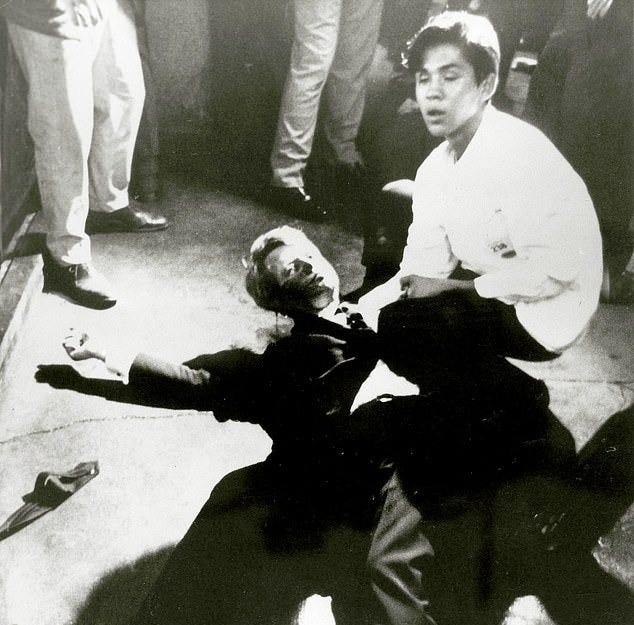
And in photos from the scene, Kennedy appears to be lying on top of Cesar, clutching his clip-on tie—the one he supposedly yanked off while being shot.
Cesar was never charged.
Never really investigated.
Just... slipped into the margins of history.
The Cover-Up Nobody Talks About
RFK Jr. didn’t just stop at the bullets. He followed the paper trail—and what he found painted a disturbing picture of a stage-managed trial.
Sirhan’s lawyer? Grant Cooper. He had mob connections. He previously represented Johnny Roselli, a known mafia hitman tied to the CIA and JFK’s assassination.
That same lawyer was under federal investigation at the time he showed up—mysteriously—as Sirhan’s defense counsel.
He told Sirhan to plead guilty immediately, suppressing ballistics evidence and blocking any real challenge to the official narrative.
Meanwhile, ballistics tests showed the bullets that killed RFK came from a different gun than the one Sirhan used.
No real trial. No confrontation of the evidence.
Just a confession, a closed case, and a public eager to move on.
Not a Theory. A Challenge.
RFK Jr. isn’t some wild-eyed conspiracy theorist. He’s a trained environmental lawyer. A lifelong skeptic. And for years, he believed the official story—because it was easier.
But after reading the coroner’s report, talking to witnesses, and walking the path his father did that night, he came to a grim, unavoidable conclusion:
“There is no way—no way—Sirhan killed my father.”
He’s now publicly calling for a reopening of the case, an independent investigation, and a real trial—something his father never got.
So... Why Does It Still Matter?
Because this wasn’t just another political tragedy.
This was a possible state-sponsored execution of a man running for President of the United States. A man calling for peace, civil rights, and an end to the Vietnam War.
And if the system could erase that, cover it up, and gaslight the nation into moving on—what else could it erase?
POLITICAL MOTIVES: Who Stood to Gain?
Let’s set aside bullets for a minute and ask the question that always matters most in a political killing:
Who stood to gain?
Because assassinations—real ones, not just tabloid-level drama—aren’t usually about chaos. They’re about control.
And when Robert F. Kennedy died, a lot of people quietly breathed a sigh of relief.
Here’s why.
The War Machine Was in Trouble
By 1968, Vietnam had become a gaping wound on America’s conscience—and its budget.
RFK wasn’t just critical of the war. He was calling for a total withdrawal.
His position wasn’t vague. It was a full-on challenge to the military-industrial complex, and unlike most critics, Kennedy had a real shot at power. He was winning primaries. His crowds were massive. His message was resonating.
If elected, RFK could’ve done what his brother never got the chance to: pull the plug on the war, hard and fast.
That’s a nightmare for:
Defense contractors (like Raytheon)
CIA operatives running shadow ops in Southeast Asia (or smuggling them through a “count”)
Oil interests with global ambitions (like Occidental Petroleum)
All the quiet people who profit from conflict
The CIA’s Long Memory
The Kennedy brothers weren’t exactly popular in Langley.
JFK had already fired CIA Director Allen Dulles after the Bay of Pigs fiasco. RFK, as Attorney General, doubled down on that animosity—demanding oversight, questioning operations, and trying to rein in black budgets and covert actions.
RFK wasn’t just a threat to the CIA’s influence. He was a Kennedy—and he knew where the bodies were buried.
Figuratively... and maybe literally.
Lyndon Johnson Had a Problem
It’s uncomfortable to say, but we need to say it:
RFK was running to replace Lyndon B. Johnson, and the two despised each other.
Not politically—personally. The hatred was legendary.
By 1968, LBJ had withdrawn from the race, but RFK’s rise still threatened Johnson’s legacy, power base, and inner circle. RFK would’ve likely investigated corruption, cut ties to hawks in Johnson’s administration, and rewritten the future of the Democratic Party.
The establishment didn’t want reform. They wanted predictability. And RFK? He was not what they wanted.
The Mob Had History
Let’s not forget—the mob had a motive too.
They helped JFK win in 1960. RFK, as Attorney General, turned around and declared war on them. He humiliated mob bosses in Senate hearings. He took their money, then broke their teeth.
When someone bites the hand that feeds them—and does it on live TV—the mob doesn’t forget.
Foreign Powers Watched Closely
RFK supported Israel, yes—but he was also open to Palestinian grievances, Cuban normalization, and diplomatic solutions with the Soviet Union. His presidency would've shifted the entire post–Cold War order before it even solidified.
So was it just one group that wanted him gone?
Maybe not.
Maybe it was several groups, loosely aligned by one unspoken truth:
RFK couldn’t be allowed to win.
The Day After: Who Benefited?
After Kennedy’s death:
The Democratic nomination went to Hubert Humphrey, who didn’t even enter a single primary.
The Vietnam War continued for another five years.
The CIA kept its claws in foreign affairs.
The mob faced less scrutiny.
Nixon won the presidency.
And the hopes for a more progressive, peace-focused White House died on a hotel kitchen floor.
No policies were reversed. No systems were dismantled.
Everything Kennedy threatened... survived.
Which should make us ask, not who pulled the trigger—but who needed him gone the most?
THE MOST MOTIVE
It’s the question that won’t let go.
Not just who pulled the trigger in that cramped hotel kitchen—but who benefited most when Robert F. Kennedy’s voice was silenced. The war lobby? The CIA? The mob? Maybe all of them. Maybe none of them directly.
But when you zoom out—when you stop looking at the individual actors and start tracing the shadows that connect them—something bigger takes shape.
It’s not just about RFK.
It’s about power without oversight.
Violence without accountability.
Control without a face.
And Robert Kennedy wasn’t the first person to threaten that system.
He just might’ve been the last one they were afraid of.
That is, until people started digging again.
The Wheel That Keeps Turning
In our next deep dive, we follow the trail into something far bigger—what former air force officer Colonel Towner-Watkins calls “The Wheel of Black Operations.”
She’s spent decades unraveling the network: a multi-headed, transnational force made up of intelligence agencies, defense contractors, front companies, and deep-state cutouts.
She calls it The International Syndicate.
It’s not a conspiracy theory. It’s a parallel power structure—and it’s been hiding in plain sight since the Cold War.
We’ll start where the wheel was first forged: Operation Gladio—NATO’s stay-behind network turned global sabotage machine.
So if you thought the RFK assassination was a one-off?
Think again.
POPULAR ARTICLES AND SERIES
The Good Shepherd: Part 1/3 – Unmasking the CIA and MI6’s Hidden History
When The Good Shepherd hit theaters in 2006, it landed quietly—too quietly for a film that dared to poke its fingers deep into the heart of the American intelligence machine.
THE PLAYBOOK: 8 Red Flags of a CIA-Backed Regime Change
In the theater of global politics, not every revolution is what it seems. One month a nation is stable—quiet, maybe even thriving.


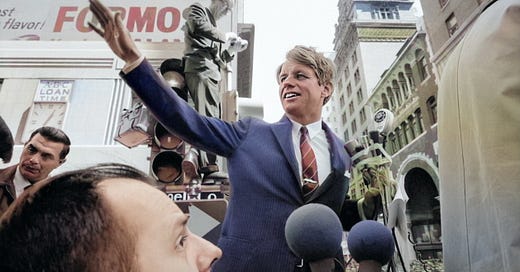





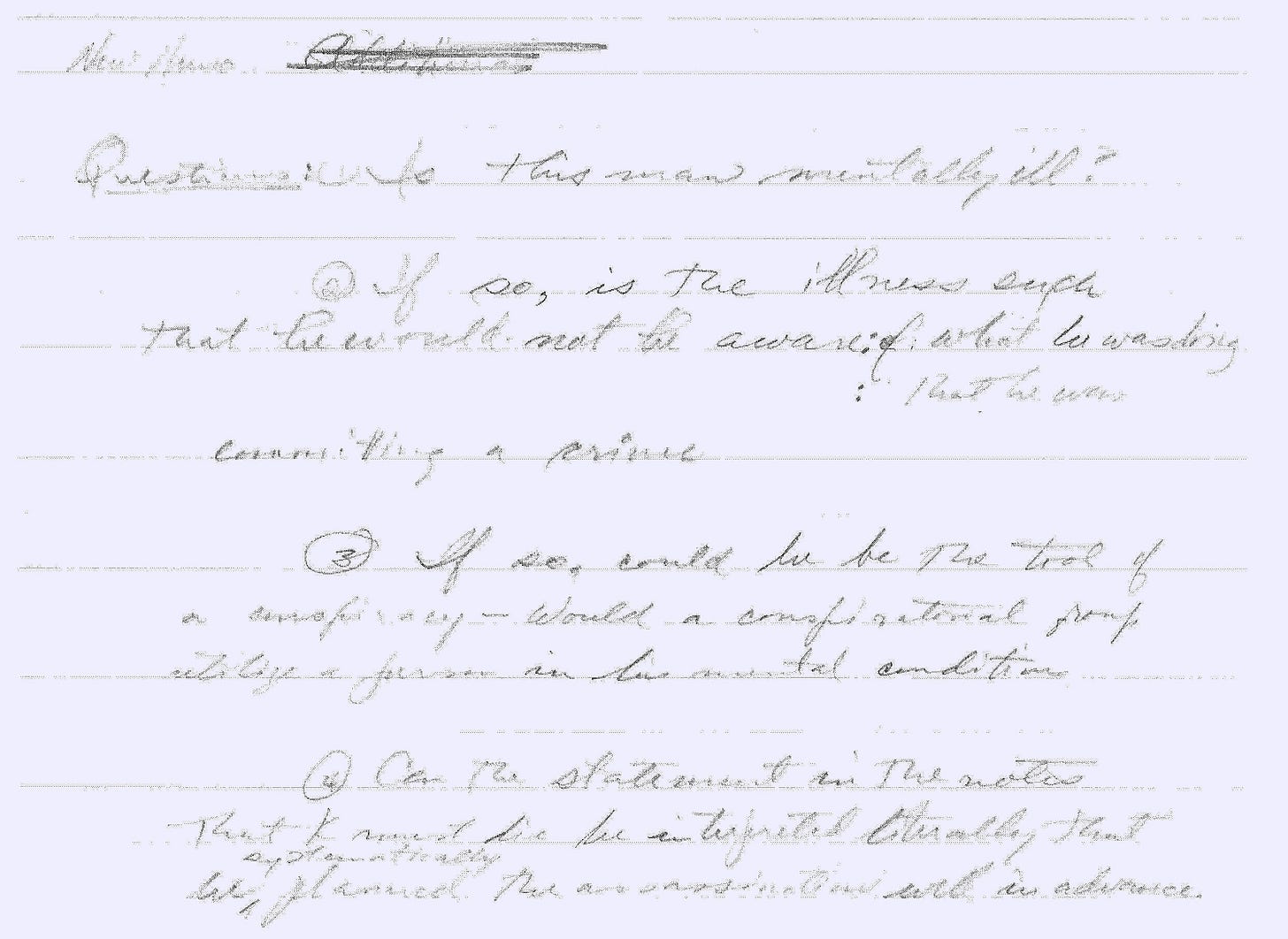

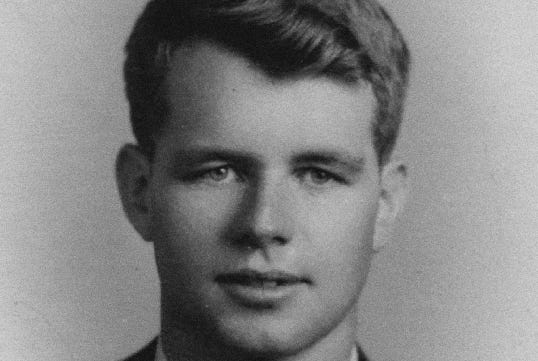
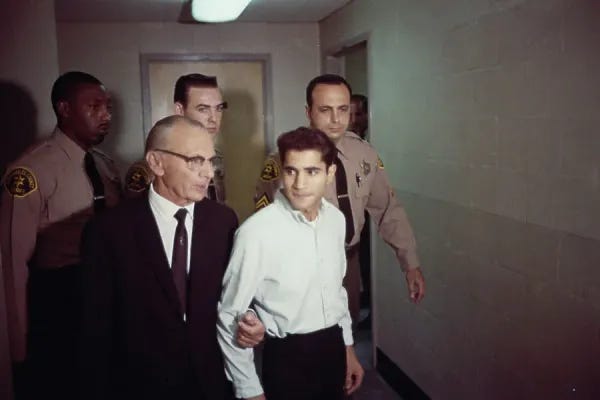


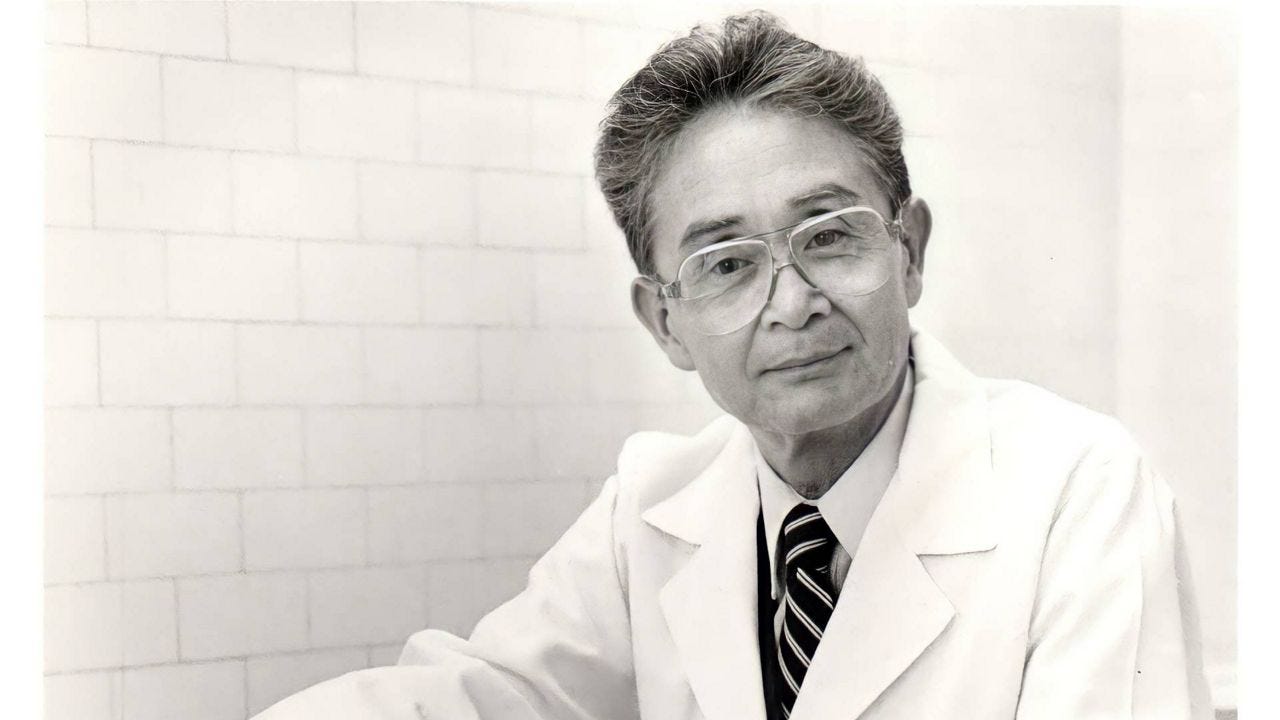
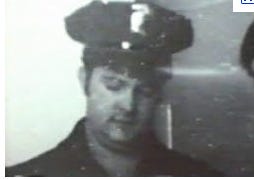



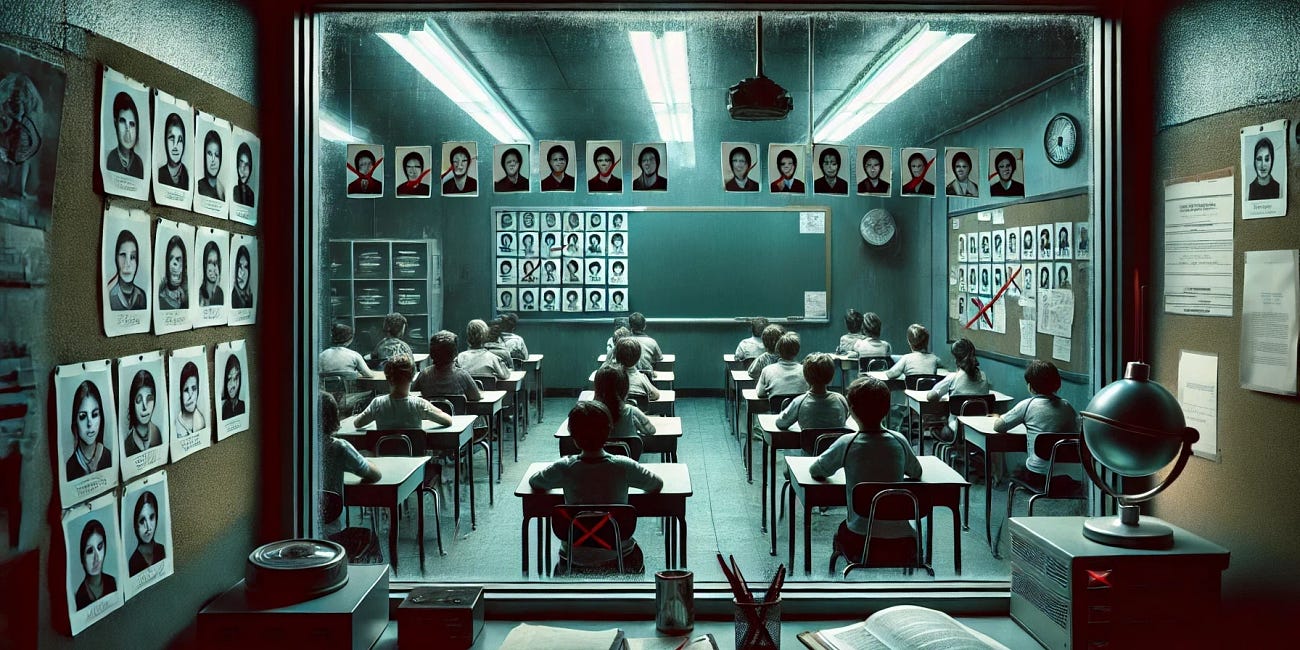
that’s terrible. Ok, Now moving on to the current issues with our 1938 German style , emotionally immature, egotistical, self centered, narcissistic, uneducated, unempathetic, man-child dictator that is throwing a tantrum like a spoiled brat….
Be careful guys. I betcha this is all bull shit to be a distraction. NOTE there is no back up documentation!!!!!! Bull Shit